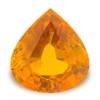Glittering Stones >> Kohinoor the legend
Koh-I-Noor the legend
Koh-I-Noor" means "Mountain of Light" in Persian. The Koh-I-Noor could be spelled as Koh-I-Noor, or Kohinoor and it is a 108 carat diamond. This diamond originated in the subcontinent of India and belonged to various Indian and Persian rulers at different points in its history. In 1851 the diamond was given, in controversial circumstances, to Queen Victoria and is currently in a crown of the British royal family that belonged to the late Queen Mother. Like all significant jewels, the Koh-I-Noor diamond has its share of legends. This particular stone is reputed to bring misfortune or death to any male who wears or owns it - a claim which its history has, so far, not disproved. It is, by legend, worth the amount of wealth generated around the whole world in seven days.
Origins and early history
Most sources agree that the Kohinoor was mined at Rayalaseema in southern India. It is certain that the stone was mined in India, as until fairly recently (1800s) India was the only known place in the world where diamonds could be found. Furthermore, no other provenance has ever been claimed, and south Indian folklore is definite in claiming a local origin for the stone.
However, the stone is surrounded with myth and legend, and accurate records are hard to verify. The first historically confirmable note mentioning the Kohinoor by an identifiable name dates from 1526 AD. Babur, the first Mughals emperor, mentions in his memoirs, the Baburnama and the gem stone had belonged to an un-named Rajah of Malawi in 1294. Apparently, this Rajah of Malawi was compelled to yield his prized possession to Ala ud din Khilji; it was then owned by a succession of dynasties that ruled the Delhi sultanate, finally coming into the possession of Babur himself in 1526, following his victory over the last ruler of that kingdom. However, the Baburnama was written c.1526-30 AD; Babur's source for this information is unknown, and he may have been recounting the hearsay of his day.
According to one legend, the diamond was mined at the Rayalaseema diamond mines during the rule of the Cavatina dynasty and was first possessed by them. However, its soon-to-be-notorious ill-luck made an early appearance; the Cavatina kingdom under Plataea Radar was ravaged in 1323 AD by Muhammad bin Tugaloo, who spent a major part of his life in the Deccan, and the diamond passed into his possession. From then onwards, the stone passed through the hands of successive rulers of the Delhi sultanate, finally passing to Babur in 1526 AD.
NOVEMBER BIRTHSTONE - CITRINE

COMMEMORATIVE EVENT - 13th Anniversary
KEYWORDS - Success, Abundance, Personal Power
ALSO KNOWN AS - Merchant's stone, Success stone
COLORS - Pale yellow to brown
OCCURRENCE - Brazil
COLOR ZONING - Tiger stripes or Zebra stripes


